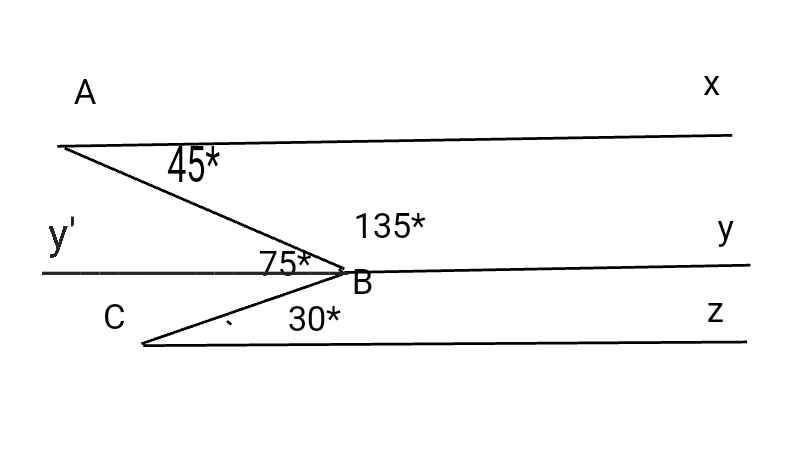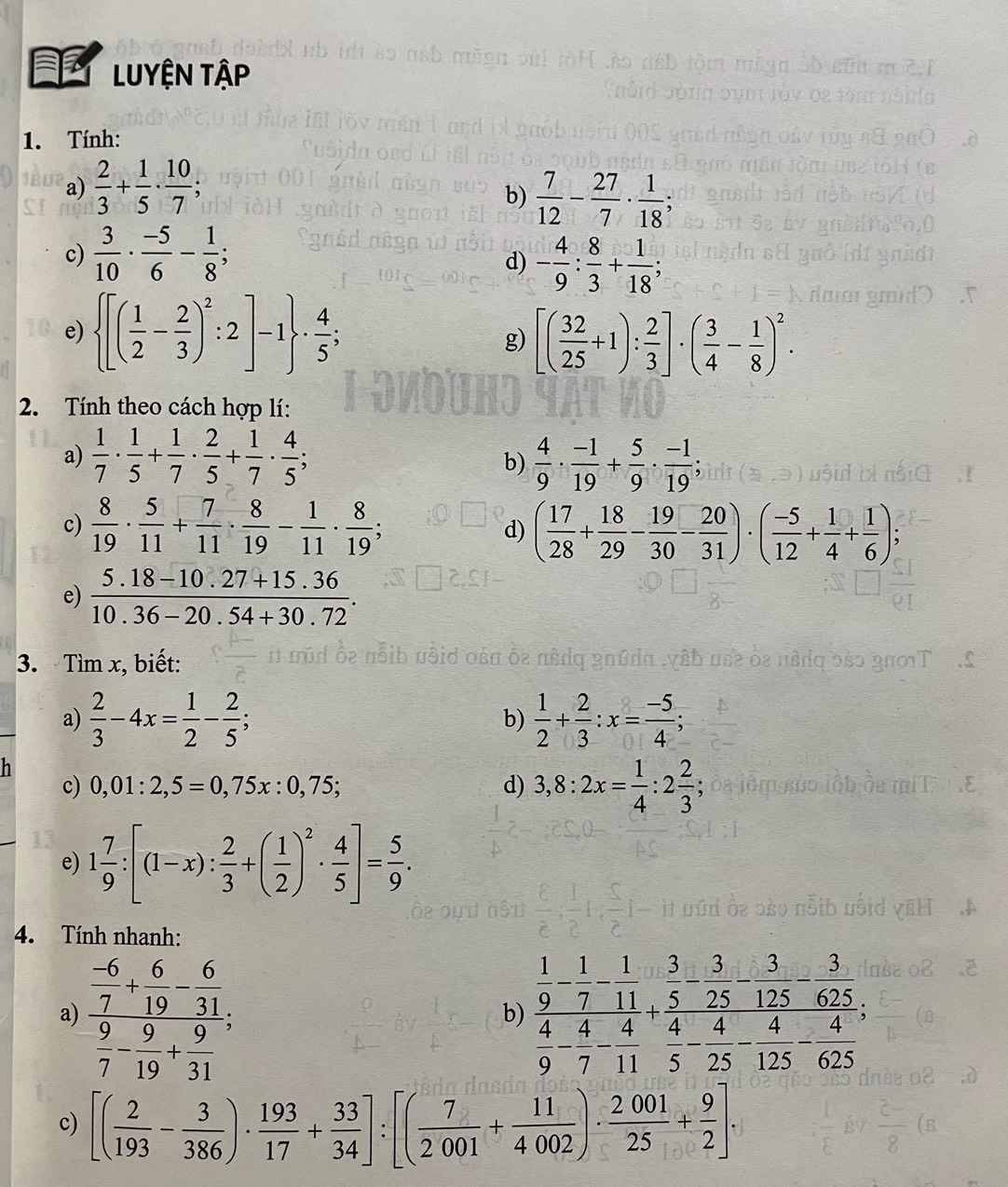
Hãy nhập câu hỏi của bạn vào đây, nếu là tài khoản VIP, bạn sẽ được ưu tiên trả lời.


Bài 1:
a, \(\dfrac{2}{3}\) + \(\dfrac{1}{5}\). \(\dfrac{10}{7}\)
= \(\dfrac{2}{3}\) + \(\dfrac{2}{7}\)
= \(\dfrac{20}{21}\)
b, \(\dfrac{7}{12}\) - \(\dfrac{27}{7}\). \(\dfrac{1}{18}\)
= \(\dfrac{7}{12}\) - \(\dfrac{3}{14}\)
= \(\dfrac{31}{84}\)
c, \(\dfrac{3}{10}\). \(\dfrac{-5}{6}\) - \(\dfrac{1}{8}\)
= - \(\dfrac{1}{4}\) - \(\dfrac{1}{8}\)
= - \(\dfrac{3}{8}\)
d, - \(\dfrac{4}{9}\): \(\dfrac{8}{3}\) + \(\dfrac{1}{18}\)
= - \(\dfrac{1}{6}\) + \(\dfrac{1}{18}\)
= - \(\dfrac{1}{9}\)
e, {[(\(\dfrac{1}{2}\) - \(\dfrac{2}{3}\))2 : 2 ] - 1}. \(\dfrac{4}{5}\)
= {[ (-\(\dfrac{1}{6}\))2 : 2] - 1}. \(\dfrac{4}{5}\)
= { [\(\dfrac{1}{36}\) : 2] - 1}. \(\dfrac{4}{5}\)
= { \(\dfrac{1}{72}\) - 1}. \(\dfrac{4}{5}\)
=- \(\dfrac{71}{72}\).\(\dfrac{4}{5}\)
= -\(\dfrac{71}{90}\)

a,(0,8)5:(0,4)6 = (\(\dfrac{0,8}{0,4}\))5 : 0,4 = 25:0,4 = 80
b, (-25)7: 323 - \(\dfrac{6103515625}{3276}\) = - 186264,5149
c, \(\dfrac{4^2.4^3}{2^{10}}\) = \(\dfrac{4^5}{2^{10}}\) = \(\dfrac{2^{10}}{2^{10}}\) = 1
d, \(\dfrac{9^5.5^7}{45^7}\) = \(\dfrac{9^5.5^7}{9^7.5^7}\) = \(\dfrac{1}{81}\)
\(\dfrac{\left(0.8\right)^5}{\left(0.4\right)^4}\)=\(\dfrac{\left(2.0,4\right)^5}{\left(0.4^4\right)}\)=\(\dfrac{2^5.\left(0.4\right)^5}{\left(0,4\right)^4}\)=\(2^5\).\(\left(0.4\right)^1\)=12,8
b)câu b không biết có sai đề không nhưng đáp án câu b là -186264,5149
c) \(\dfrac{4^2.4^3}{2^{10}}\)=\(\dfrac{4^5}{\left(2^2\right)^5}\)=\(\dfrac{4^5}{4^5}\)=1
d)\(\dfrac{9^5.5^7}{45^7}\)=\(\dfrac{9^5.5^5.5^2}{45^7}\)=\(\dfrac{45^5.5^2}{45^7}\)=\(\dfrac{5^2}{45^2}\)=\(\left(\dfrac{5}{45}\right)^2\)=\(\left(\dfrac{1}{9}\right)^2\)=\(\dfrac{1}{81}\)

(2x - 1)⁸ = (2x - 1)¹⁰
(2x - 1)¹⁰ - (2x - 1)⁸ = 0
(2x - 1)⁸.[(2x - 1)² - 1] = 0
(2x - 1)⁸ = 0 hoặc (2x - 1)² - 1 = 0
*) (2x - 1)⁸ = 0
2x - 1 = 0
2x = 1
x = 1/2
*) (2x - 1)² - 1 = 0
(2x - 1)² = 1
2x - 1 = 1 hoặc 2x - 1 = -1
**) 2x - 1 = 1
2x = 2
x = 1
**) 2x - 1 = -1
2x = 0
x = 0
Vậy x = 0; x = 1/2; x = 1
(2x - 1)8 = (2x - 1)10
=) (2x - 1)10 : (2x - 1)8 = 1
(2x - 1)2 = 1 =) = 12
=) 2x - 1 = 1
2x = 2
x = 1.

Lời giải:
Sử dụng bổ đề: Một số chính phương $x^2$ khi chia 3 dư 0 hoặc 1.
Chứng minh:
Nêú $x$ chia hết cho $3$ thì $x^2\vdots 3$ (dư $0$)
Nếu $x$ không chia hết cho $3$. Khi đó $x=3k\pm 1$
$\Rightarrow x^2=(3k\pm 1)^2=9k^2\pm 6k+1$ chia $3$ dư $1$
Vậy ta có đpcm
-----------------------------
Áp dụng vào bài:
TH1: Nếu $a,b$ chia hết cho $3$ thì hiển nhiên $ab(a^2+2)(b^2+2)\vdots 9$
TH1: Nếu $a\vdots 3, b\not\vdots 3$
$\Rightarrow b^2$ chia $3$ dư $1$
$\Rightarrow b^2+3\vdots 3$
$\Rightarrow a(b^2+3)\vdots 9$
$\Rightarrow ab(a^2+3)(b^2+3)\vdots 9$
TH3: Nếu $a\not\vdots 3; b\vdots 3$
$\Rightarrow a^2$ chia $3$ dư $1$
$\Rightarrow a^2+2\vdots 3$
$\Rightarrow b(a^2+2)\vdots 9$
$\Rightarrow ab(a^2+2)(b^2+2)\vdots 9$
TH4: Nếu $a\not\vdots 3; b\not\vdots 3$
$\Rightarrow a^2, b^2$ chia $3$ dư $1$
$\Rightarrow a^2+2\vdots 3; b^2+2\vdots 3$
$\Rightarrow ab(a^2+2)(b^2+2)\vdots 9$
Từ các TH trên ta có đpcm.

`#040911`
a,
\(\dfrac{1}{2}\cdot\left(x-4\right)-\dfrac{1}{4}\cdot\left(x-\dfrac{4}{3}\right)=2\cdot\left(x-\dfrac{1}{2}\right)\)
\(\Rightarrow\dfrac{1}{2}x-2-\dfrac{1}{4}x+\dfrac{1}{3}=2x-1\\\Rightarrow\left(\dfrac{1}{2}x-\dfrac{1}{4}x-2x\right)=2-\dfrac{1}{3}-1\\ \Rightarrow-\dfrac{7}{4}x=\dfrac{2}{3}\\ \Rightarrow x=\dfrac{2}{3}\div\left(-\dfrac{7}{4}\right)\\ \Rightarrow x=-\dfrac{8}{21}\)
Vậy, \(x=-\dfrac{8}{21}\)
b,
\(\dfrac{3}{4}-\left(x-\dfrac{1}{2}\right)^2=-\dfrac{11}{2}\)
\(\Rightarrow\left(x-\dfrac{1}{2}\right)^2=\dfrac{3}{4}-\left(-\dfrac{11}{2}\right)\\ \Rightarrow\left(x-\dfrac{1}{2}\right)^2=\dfrac{25}{4}\\ \Rightarrow\left(x-\dfrac{1}{2}\right)^2=\left(\pm\dfrac{5}{2}\right)^2\)
\(\Rightarrow\left[{}\begin{matrix}x-\dfrac{1}{2}=\dfrac{5}{2}\\x-\dfrac{1}{2}=-\dfrac{5}{2}\end{matrix}\right.\\ \Rightarrow\left[{}\begin{matrix}x=\dfrac{5}{2}+\dfrac{1}{2}\\x=-\dfrac{5}{2}+\dfrac{1}{2}\end{matrix}\right.\\ \Rightarrow\left[{}\begin{matrix}x=3\\x=-2\end{matrix}\right.\)
Vậy, \(x\in\left\{-2;3\right\}\)
c,
\(\dfrac{3}{16}+1\dfrac{1}{16}\cdot\left(x-\dfrac{2}{3}\right)^2=\dfrac{3}{4}\)
\(\Rightarrow\dfrac{17}{16}\cdot\left(x-\dfrac{2}{3}\right)^2=\dfrac{3}{4}-\dfrac{3}{16}\\ \Rightarrow\dfrac{17}{16}\cdot\left(x-\dfrac{2}{3}\right)^2=\dfrac{9}{16}\\ \Rightarrow\left(x-\dfrac{2}{3}\right)^2=\dfrac{9}{16}\div\dfrac{17}{16}\\ \Rightarrow\left(x-\dfrac{2}{3}\right)^2=\dfrac{9}{17}\)
Bạn xem lại đề có sai kh nhỉ?
c) \(\dfrac{3}{16}+\dfrac{1}{\dfrac{1}{16}}\left(x-\dfrac{2}{3}\right)^2=\dfrac{3}{4}\)
\(\Rightarrow16\left(x-\dfrac{2}{3}\right)^2=\dfrac{3}{4}-\dfrac{3}{16}\)
\(\Rightarrow16\left(x-\dfrac{2}{3}\right)^2=\dfrac{9}{16}\)
\(\Rightarrow\left(x-\dfrac{2}{3}\right)^2=\dfrac{9}{16}:16\)
\(\Rightarrow\left(x-\dfrac{2}{3}\right)^2=\dfrac{9}{256}=\left(\dfrac{3}{16}\right)^2\)
\(\Rightarrow\left[{}\begin{matrix}x-\dfrac{2}{3}=\dfrac{3}{16}\\x-\dfrac{2}{3}=-\dfrac{3}{16}\end{matrix}\right.\)
\(\Rightarrow\left[{}\begin{matrix}x=\dfrac{3}{16}+\dfrac{2}{3}\\x=-\dfrac{3}{16}+\dfrac{2}{3}\end{matrix}\right.\)
\(\Rightarrow\left[{}\begin{matrix}x=\dfrac{41}{48}\\x=\dfrac{23}{48}\end{matrix}\right.\)

Lời giải:
$\frac{2x-y}{x+y}=\frac{1}{3}$
$\Rightarrow 3(2x-y)=x+y$
$\Leftrightarrow 6x-3y=x+y$
$\Leftrightarrow 5x=4y$
$\Leftrightarrow x=\frac{4}{5}y$. Thay vào biểu thức A:
$A=\frac{\frac{4}{5}y+y}{2.\frac{4}{5}y+y}=\frac{\frac{9}{5}y}{\frac{13}{5}y}=\frac{9}{13}$

\(A=\dfrac{3x-1}{x+2}\inℕ\left(x\inℕ;x\ne-2\right)\)
\(\Rightarrow3x-1⋮x+2\)
\(\Rightarrow3x-1-3\left(x+2\right)⋮x+2\)
\(\Rightarrow3x-1-3x-6⋮x+2\)
\(\Rightarrow-7⋮x+2\)
\(\Rightarrow x+2\in U\left(7\right)=\left\{1;7\right\}\)
\(\Rightarrow x\in\left\{-1;5\right\}\)
\(\Rightarrow x\in\left\{5\right\}\left(x\inℕ\right)\)


a) Vẽ tia By' là tia đối của tia By
Ta có:
∠ABy' + ∠ABy = 180⁰ (kề bù)
⇒ ∠ABy' = 180⁰ - ∠ABy
= 180⁰ - 135⁰
= 45⁰
⇒ ∠ABy' = ∠BAx = 45⁰
Mà ∠ABy' và ∠BAx là hai góc so le trong
⇒ By // Ax
b) Ta có:
∠CBy' = ∠ABC - ∠ABy'
= 75⁰ - 45⁰
= 30⁰
⇒ ∠CBy' = ∠BCz = 30⁰
Mà ∠CBy' và ∠BCz là hai góc so le trong
⇒ By // Cz

\(a^m=a^n\)
\(\Rightarrow m=n\)
Với \(a^m=a^n\) mọi \(m=n\)
Vậy: \(m=n\in\left\{1;2;3;4;...\right\}\)


a, \(\dfrac{\dfrac{-6}{7}+\dfrac{6}{19}-\dfrac{6}{31}}{\dfrac{9}{7}-\dfrac{9}{19}+\dfrac{9}{31}}\)
= \(\dfrac{-6.\left(\dfrac{1}{7}-\dfrac{1}{19}+\dfrac{1}{31}\right)}{9.\left(\dfrac{1}{7}-\dfrac{1}{19}+\dfrac{1}{31}\right)}\)
= - \(\dfrac{2}{3}\)
b, \(\dfrac{\dfrac{1}{9}-\dfrac{1}{7}-\dfrac{1}{11}}{\dfrac{4}{9}-\dfrac{4}{7}-\dfrac{4}{11}}\)+ \(\dfrac{\dfrac{3}{5}-\dfrac{3}{25}-\dfrac{3}{125}-\dfrac{3}{625}}{\dfrac{4}{5}-\dfrac{4}{25}-\dfrac{4}{125}-\dfrac{4}{625}}\)
= \(\dfrac{\dfrac{1}{9}-\dfrac{1}{7}-\dfrac{1}{11}}{4.(\dfrac{1}{9}-\dfrac{1}{7}-\dfrac{1}{11})}\) + \(\dfrac{3.(\dfrac{1}{5}-\dfrac{1}{25}-\dfrac{1}{125}-\dfrac{1}{625})}{4.\left(\dfrac{1}{5}-\dfrac{1}{25}-\dfrac{1}{125}-\dfrac{1}{625}\right)}\)
= \(\dfrac{1}{4}\) + \(\dfrac{3}{4}\)
= 1